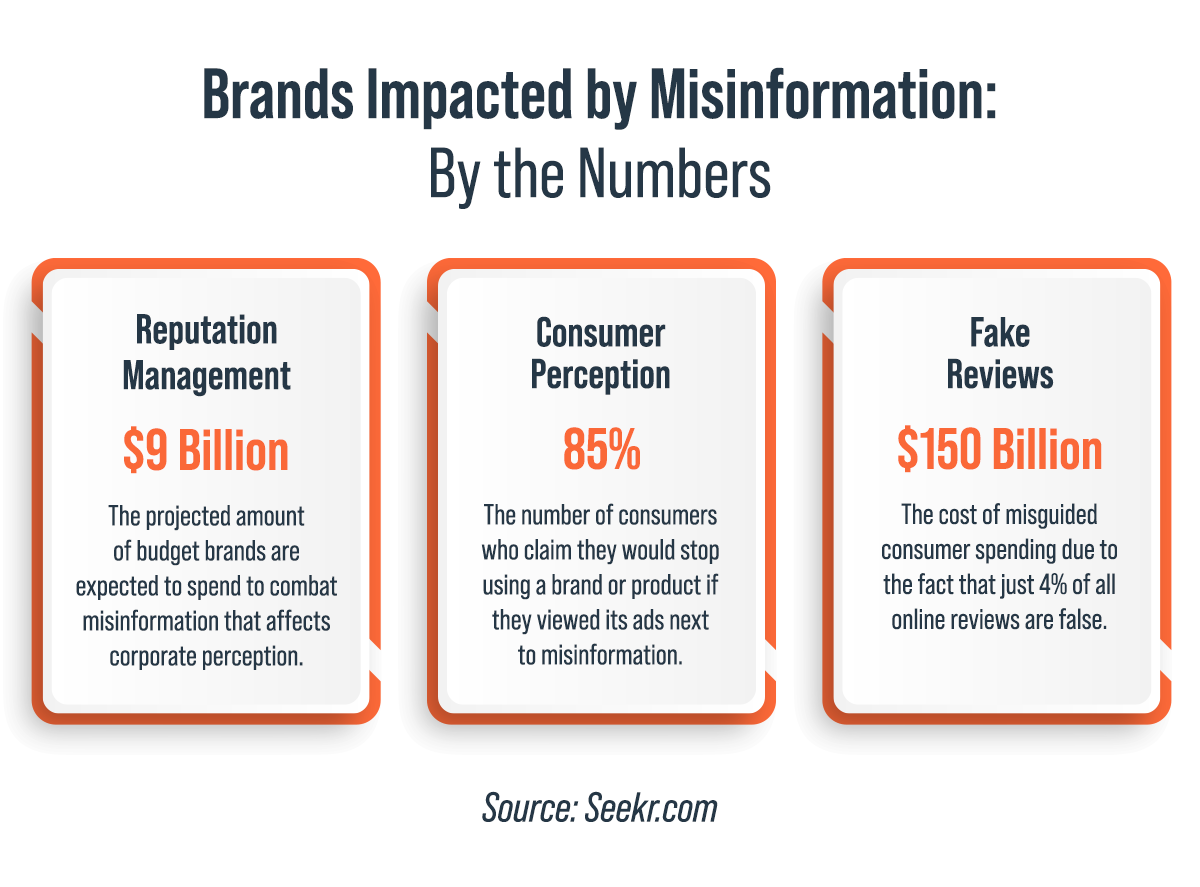Misinformation is not a new concept. In fact, due to human error, it’s likely that the effects of misinformation existed long before the printing press was even invented.
However, with the ability to consume, share, and offer opinions on any piece of information on the Internet at the click of a button, it’s no wonder misinformation is on the rise. Found in our search results, social media, news, and wherever bots or trolls tend to thrive, it’s becoming an ongoing barrier for brands looking to build consumer trust and loyalty among their best audiences.
How Are Brands Paying the Price?
With the cost of misinformation affecting budget, perception, and the consumer experience, the threat misinformation presents to brands appears to grow by the day, which clearly affects a brand’s bottom line.

And because misinformation runs rampant throughout digital media, it can be tough for brands to navigate. Marketers are well aware of this threat, with “42% worrying about the detrimental effect on their brand’s reputation for advertising alongside misinformation,” per data from Integral Ad Science.
“It is estimated that at least $235m of ad budgets every year is unwittingly spent advertising on sites that peddle misinformation,” Csaba Szabo, managing director at Integral Ad Science, writes for The Drum. “This money, along with the air of legitimacy that ads by global brands lend to these sites, only perpetuates the issue.”
Not to mention, misinformation has even started causing brands to take stances on public issues, which has led to some unintended backlash.
How Can Brands Protect Themselves?
Fortunately, with the right team and tactics in place, marketing on the Internet doesn’t have to be a minefield for brands trying to grow their business. Here are three ways brands can prevent misinformation from affecting their digital marketing strategy.
Targeting and Channel Strategy
Identify ideal consumers and where they spend their time online. With this information, brands can audit conversations happening across particular platforms and devise a messaging strategy that effectively navigates around the effects of misinformation.
In particular, knowing these audiences, where they tend to thrive, and what they’re talking about could also lend to some intriguing new opportunities in paid media, allowing brands to place the right message at the right place at the right time more safely.
Social Justice and Transparency
One study claims that “two-thirds of consumers say it’s important for brands to take stands on social and political issues.”
However, that doesn’t mean brands should hop on every issue circulating the news cycle. Brands should always do their due diligence when researching social justice issues, gaining a clear, 360° understanding of the issues at hand and how they relate to their business. This allows brands the ability to be transparent about their intentions while also avoiding being super-spreaders of misinformation themselves.
Monitoring and Crisis Management
Maintaining a courteous and professional persona online is a great way to manage communities laden with misinformation. Be proactive by creating a response matrix for crisis management teams focused on issue escalation in order to protect corporate reputation.
But, not only that, new social listening tools—such as Newsguard’s integration with Meltwater—are being introduced by the day intent on helping brands identify and mitigate misinformation.
Let’s Create Together
Want to learn how your brand can navigate around misinformation—but not sure where to start? Drop us a line at info@againinteractive.com. Your success is how we measure ours.

Anthony Galasso
Part of AGAIN Interactive's spirited creative team since 2014, Anthony Galasso is passionate about all aspects of digital marketing from strategy through execution and beyond. In his spare time, Anthony also loves to travel, try new foods, plays drums, and hike with his beagle, Hailey.
